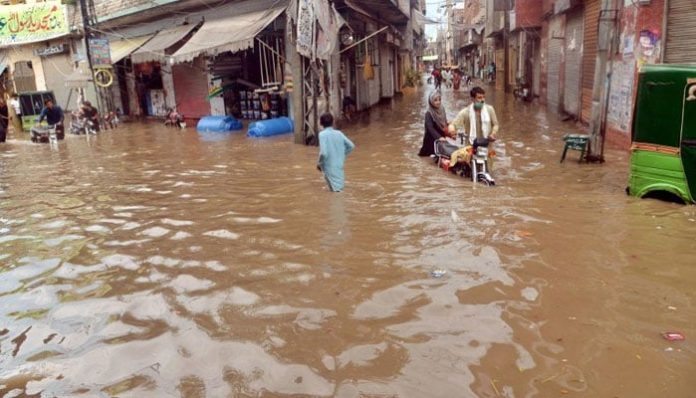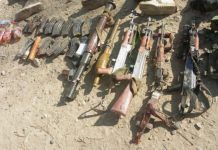—– Latest downpour comes just a day after record-breaking rain in the city
Staff Report
ISLAMABAD: At least 17 people lost their lives on Thursday while 49 others were injured in multiple incidents of roof and wall collapses across Punjab as rains continued to batter parts of the province for a second consecutive day.
Detailing the deaths, the Provincial Disaster Management Authority (PDMA) said in a statement that four people — including three children under the age of 10 — were killed in Lahore after the roof of a house near the Bandianwala bridge in the city’s Amar Sidhu area collapsed due to heavy rainfall.
In a separate incident, 14 people were injured as a wall of the Government Mozang Teaching Hospital, adjoining a neighbouring building, collapsed. They were shifted to Sir Ganga Ram Hospital.
According to the PDMA, six deaths were reported in Gujranwala after a “weak wooden structure” inside a three-storey house collapsed. In similar incidents, three people each were killed in Chakwal and Sheikhupura while one person each died in Jhang and Faisalabad. It said 32 people across the province had sustained severe injuries in multiple rain-related incidents. “They have been moved to the hospital and are being provided medical aid.”
The PDMA added that it was monitoring the situation from its provincial con-trol room and was in contact with the administration.
In Lahore, the Water and Sanitation Agency (Wasa) Monsoon Control Room recorded the highest amount of rainfall at the Nishtar Town director office at 65mm, followed by the Johar Town SDO office at 57mm and Lakshmi Chowk at 38mm.
The locations which received the least amount of rainfall were Upper Mall at 3.5mm, the Mughalpura SDO office at 5mm and the airport area at 5.5mm.
Meanwhile, Punjab caretaker Chief Minister Mohsin Naqvi said that today “everything was under control”. Speaking to reporters in Lahore, he said that eight secretaries were monitoring one whole Wasa zone each. He added that some ministers had been allotted divisions to monitor while others had gone to the divisional headquarters.
He also commented on the flood alert issued for the province, saying, “Com-missioners and deputy commissioners have already started working on this. The chief secretary chaired a meeting in the morning regarding this. The whole administration is working on this.”
On Wednesday, nine people across Punjab had lost their lives in different inci-dents of electrocution, roof collapses, drowning and lightning. CM Naqvi had termed the “record” rainfall received by Lahore — 291 millimetres — as unex-pected.
Lahore Commissioner Muhammad Ali Randhawa had echoed similar views, noting that such a large amount of rainfall in such a short amount of time had not been received for the past 30 years.
Wasa’s “record-breaking” claim, however, was contested by the Met Office when one of its officials, who did not want to be named, termed it “self-serving”, as it gave more time and resources to the agency to clear water from the city.
Wasa MD reviews drainage work
Earlier today, Wasa Managing Director Ghufran Ahmed reviewed the drainage operations at various underpasses in Lahore, including Captain Mubeen Sha-heed Underpass, and roads of the provincial capital.
He asserted that “all disposal stations were functioning at their full capacity” and also ordered for the fuel supply for all generators draining the floodwater to be ensured.
Meanwhile, an official statement by Punjab Chief Secretary Zahid Akhtar Za-man’s office said he was “present on the field to review the preparations for water drainage”.
Noting that Zaman visited “various roads and the Kalma Chowk underpass”, the statement quoted him directing all officers to remain on the field as well.
It further quoted the chief secretary as directing the secretaries of departments to assess underpasses and disposal stations.
“Special measures should be taken to keep the traffic flowing,” the statement quoted Zaman while also asserting that the official had ordered for more pumps to be installed to drain water from low-lying areas.
Authorities warn of urban floods, flash floods, landslides
A weather forecast issued this morning by the Pakistan Meteorological De-partment (PMD) warns: “Heavy rain may cause urban flooding in low-lying ar-eas of Islamabad, Rawalpindi, Attock, Gujranwala, Lahore, Sialkot, Sahiwal, Toba Tek Singh, Multan, Bahawalpur, Bahawalnagar, Okara, Kohat, Peshawar, Bannu, Karak and Dera Ismail Khan […] from July 6-8.”
It further warns that the heavy rain “may trigger landslides in the vulnerable areas of Murree, Galliyat, Kashmir, Gilgit Baltistan and hilly areas of Khyber Pakhtunkhwa”.
“Heavy falls may cause flash floods in hill torrents and local nullas of Kashmir, Dera Ghazi Khan, Kohlu, Sibbi, Barkhan, Zhob, Loralai, Qilla Saifullah and Musa Khel during the period,” it cautions.
Meanwhile, a weather warning from the PMD’s Regional Meteorological Cen-tre for Lahore states, “Due to heavy rainfall, there is a risk of land sliding and flash flooding in vulnerable areas of Punjab and Kashmir.
“There is also a risk of urban flooding in major cities of Punjab (Rawalpindi, Sargodha, Sialkot, Gujranwala, Gujrat, Lahore, Faisalabad, Jhang, Sahiwal, Bahawalpur, Multan and Dera Ghazi Khan) during July 5-9,” it adds.
A day ago, the Punjab Provincial Disaster Management Authority also issued a flood alert warning of a “very high to exceptionally high flood situation from July 8 to 10”.
Citing a PMD alert, it said that “widespread heavy to very heavy rainfall with extremely heavy falls at scattered places is expected over the upper catchments of rivers Sutlej, Ravi and Chenab, and up to some extent over River Jhelum”.
“Due to these meteorological conditions, very high to exceptionally high level flooding is expected in River Chenab,” it warned while noting that the “flood situation in rivers Ravi and Sutlej will depend upon [water] releases from In-dia”.
It went on to predict that “high to very high-level flood is expected in the nullas of River Ravi and Chenab” and requested citizens to take precautionary measures to avoid any untoward situation.




